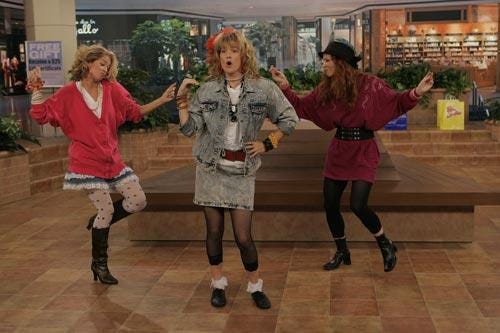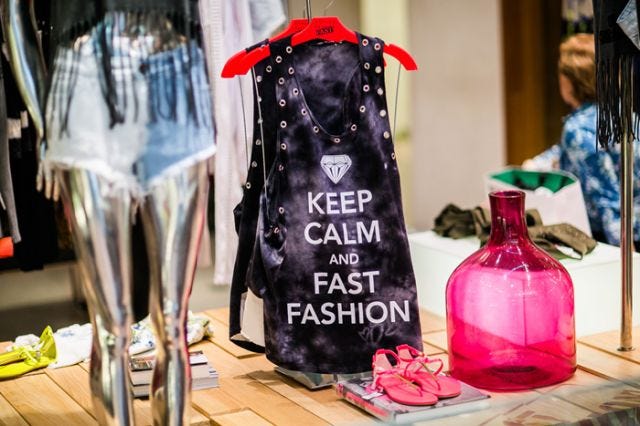So What, Who Cares (vol 2, issue 44) What the shopping mall says about the future of spending
Hello! Welcome to the end of the week. I hope your weekend is filled with as many Reese's peanut butter eggs as you can stand.
*

In the future, only the rich will shop at malls. That's the conclusion of Barbara Kahn, a Wharton marketing professor and director of the Jay H. Baker Retailing Center. She notes that emporiums which are heavy in luxury brands like Nordstrom and Apple will be able to attract moneyed shoppers because they position themselves as luxury shopping experiences, with entertainment options, restaurants, spa services and great landscaping. A recent Bloomberg analysis of the American malls -- 546 malls and 61,790 stores -- broke out some of the data by demographics, and seems to reinforce the notion that malls are self-segregating economically.
So what? The death of the American mall is the latest in a long line of indicators that income inequality and stagnant wage growth are bad for business in the U.S. (vol 1, issue 28; vol 1, issue 37) Every time another family has to knock Sears, Kmart or J.C. Penney off the list of places to shop, that's another nail in the middle-class mall coffin. As reported earlier this year:
“It is very much a haves and have-nots situation,” said D. J. Busch, a senior analyst at Green Street. Affluent Americans “will keep going to Short Hills Mall in New Jersey or other properties aimed at the top 5 or 10 percent of consumers. But there’s been very little income growth in the belly of the economy.”
However, the winnowing of malls for working-class people has been very good for the rich:
In a recent report, the real-estate research and advisory firm Green Street Advisors predicted that Class A malls—the "destination" malls in major markets—"should perform at a high level for years to come," while Class B malls will remain stable, because they "adequately serve their target shopper in a given trade area." It's the Class C and D malls whose future is dicey, and more of these will indeed likely go dark.
Who cares? People who invest in the developers who build A-list malls -- they're gonna make money.
As for the rest of us? Dead malls can enjoy second lives as churches, schools, hospitals or public parks.
Related reading: The retail trend in the U.S. is to skew high end or to discount pricing -- effectively squeezing out mid-market specialty retailers. What makes cheap retailers so alluring beyond the price point?

There's apparently a neurological component. When people are looking at consumer goods, they gain pleasure from looking at things, but the pleasure of acquisition is often tempered by a cost-benefit analysis. With fast fashion, the perceived benefit far outweighs the perceived pain of the cost. So buying cheap clothing can be a nearly addictive source of pleasure.
As for the ethical concerns attendant to fast fashion -- environmental impact, human rights (vol 1, issue 7; vol 1, issue 19; vol 1, issue 24)-- the Primark chain is aggressively addressing them in an effort to woo shoppers who have qualms:
There’s an entire section on the brand's website dedicated to answering questions like "Are workers making Primark clothing paid a fair wage?" and "Does Primark use child labour?" Needless to say, the retailer is incredibly committed to making sure its customers don’t feel like they’re giving up moral ground by shopping at Primark.
Expect the fast-fashion battle to heat up in the U.S. with Primark's arrival, especially as chains like H&M, Mango, Zara, ASOS, Topshop and Uniqlo continue to expand.
A side effect: fast fashion chains may reintroduce the retail-experience cachet to a whole new market. It often makes little sense to aggressively build out an online presence when shipping costs as much -- if not more -- than producing an item did. So prepare for incentives to shop fast fashion solely in stores.
*
Your pop culture note of the day: New York magazine rolled out an editorial package on nightlife after dark, and Michael Musto's feature, "165 Years of Club Kids," features a few names that are familiar if you've ever seen Party Monster or known my friend Molly.
A few words about Molly: She is the chicest human being I know. When we were students in upstate New York, Molly would wear backless leopard-print mules in a blizzard, yet she never got snow in her shoes. Her red lipstick has not been smudged since 1994. Molly is the reason I firmly believe you should go to art galleries with people who have studied art history, and when I got pregnant, the hand-me-downs she sent on suggested that her babies had spent their infancy dancing with Jean Dujardin.

Molly is also the reason I read Dianne Brill's Boobs, Boys and High Heels: Or How to Get Dressed in Just Under Six Hours. Brill personified the glorious excesses of 1980s NYC, and her book is both a time capsule for a bygone era and a spiritual descendant of Diana Vreeland's D.V. (vol 2, issue 20)
Brill is a woman whose idea of good advice is to have a pair of "home-use-only high heels," preferably trimmed in marabou, because they come in handy when you have to change light bulbs.
I enjoy this book because of its devotion to very specific aesthetic ideals. As Anna Johnson once wrote, "Aesthetics are more important than good taste. Aesthetics mean you have a point of view."
A few years ago, copies of Boobs, Boys and High Heels Brill's book were going for triple-digit sums at used bookstores. Today on Amazon.com, you can get a used copy for $4.
Do you have a Molly in your life? Tell me about her (or him) via Twitter or email, and let me know if I can share your story. We could all use a little more chic, no?
*
Are there typos? I apologize in advance. The only editing class I did not get an A in was copyediting.
Did you miss an issue of So What, Who Cares? The archive is here.
Would you like a run-down of all the books and other pop culture picks ever mentioned in this newsletter? Then check out the Pinterest board. (Note: None of the links are affiliate links; I do not make money off anything I link to.)
If you really like So What, Who Cares?, tell a friend to subscribe.

